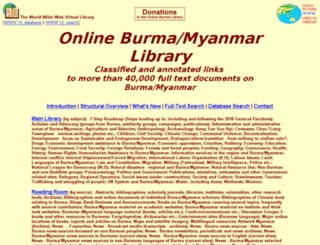Focal point
Location
The Online Burma/Myanmar Library (OBL) is a non-profit online research library mainly in English and Burmese serving academics, activists, diplomats, NGOs, CSOs, CBOs and other Burmese and international actors. It is also, of course, open to the general public. Though we provide lists of Burma/Myanmar news sources, the Library’s main content is not news but in-depth articles, reports, laws, videos and links to other websites, We provide a search engine (database and full text) and an alphabetical list of categories and sub-categories, but the Library is best accessed through browsing the 100 or so categories which lead to sub- and sub-sub categories. These tools should be used in combination.
Members:
Resources
Displaying 871 - 875 of 1151Northeastern Pa'an District: Villagers Fleeing Forced Labour Establishing SPDC Army Camps, Building Access Roads and Clearing Landmines
Information on a new flow of refugees from northeastern Pa'an District into Thailand. The villagers say that they fled their village in mid-January 2001 because SPDC troops are using them as porters, forced labour on an access road, and Army camp labour in order to strengthen the regime's control over this contested area. Worst of all, the villagers say they are being ordered to clear landmines in front of the SPDC Army's road-building bulldozer, and to make way for new Army camps.
What's Wrong in Ranong
Ranong is the second largest Burmese community in Thailand, where many migrants work in the fishing and its related industries. However, the community has been hit by an economic downturn in part caused by the loss of fishing concessions from Burma.
Burma: Displaced Karens. Like Water on the Khu Leaf
War disrupts the normal relationship between people and place.
Displaced by war, people must adapt to survive, both physically and
socially. When people are displaced for a long time, these
adaptations become normal; thus displacement starts as an
aberration but becomes a constant way of life. In eastern Burma,
'normal' displacement has led to significant changes in the political,
cultural and economic relationships between Karen people and their
'place' - both the physical space they occupy and their position in
Irrawaddy moist deciduous forests (IM0117)
Biome: Tropical and Subtropical Moist Broadleaf Forests...
Size: 53,400 square miles...
Conservation Status: Vulnerable.....
Introduction:
"Like many of the region's lowland forests, the Irrawaddy Moist Deciduous Forests [IM0117] ecoregion has been intensively cultivated and its forests converted over hundreds of years. As a consequence, most of the region's biodiversity has been extirpated, and because of political forces over the past few decades very little current information on the biodiversity status of this ecoregion is known.
Description
Myanmar coastal rain forests (IM0132)
Biome: Tropical and Subtropical Moist Broadleaf Forests...
Size: 25,700 square miles...
Conservation Status: Vulnerable.....
Introduction:
"The Myanmar Coastal Rain Forests [IM0132] are a diverse set of climatic niches and habitats that include flora and fauna from the Indian, Indochina, and Sundaic regions. Though low in endemism, this ecoregion has a tremendous species diversity. However, the forests have been increasingly destroyed to make way for agriculture, and poaching has become the dominant threat to the remaining wildlife populations.


